
Worried that you’re making, like, all the B2B blogging mistakes?
Relax. It’s natural to stress out if you’re running a blog.
I mean, you’re responsible for juggling a lot of moving pieces, right?
From researching keywords to conducting competitive analysis, there’s a ton to do before you even get to put pen to paper.
Listen: missteps happen from time to time. Minor details of your blog are easy to overlook when you’re handling so many tasks and responsibilities.
The problem? Those small errors can snowball into bigger headaches that hurt your search rankings and overall credibility over time.
This post breaks down some of the most common B2B blogging mistakes that are surprisingly simple to fix. By avoiding these mistakes, your blog is poised for more readers and organic traffic.
1. Replace stock photos on your blog with original images
Although stock photos have definitely come a long way thanks to sites like Pexels and PixaBay, pulling creatives from such sites should be the last resort for B2B bloggers.
Think about it. When hundreds (or thousands) of people are picking from the same pool of stock photos, you’re doing nothing to define your brand or stand out from the crowd.
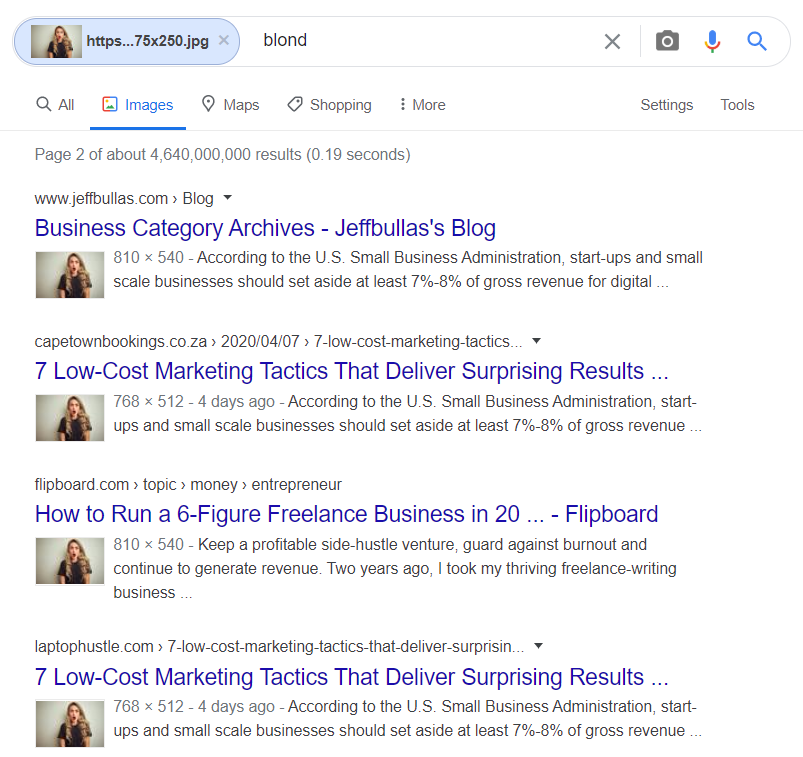
Appearances matter. Anything you can do to make your blog more professional and put together is a plus. That starts with unique blog imagery.
Thankfully, spamming stock photos is one of the easier B2B blogging mistakes to avoid considering there are so many options for bloggers to find fresh images today.
What are your options, then?
Examples of blog post images beyond stock photos
You’ve probably already noticed that many B2B blogs couple posts with custom illustrations. The beauty of using artwork is that it’s not only aesthetically pleasing but also one-of-a-kind. Such imagery allows you to cement your brand and make your blog feel distinctly you.
Here’s an awesome example from the Freshworks blog:

It’s arguably easier than ever to form long-term relationships with freelance illustrators who can create blog post images that vibe with your brand. Check out some samples of stellar work from an illustrator on Fiverr (not an affiliate link, don’t worry):

Beyond illustrations, you can likewise whip up your own graphics with tools such as Canva.
Speaking of Canva, their blog is actually another example of a no-brainer source of images: your own product or service. For example, SaaS blogs can feature screenshots of their tools in action.

Heck, even something as simple as a photo of your team is more compelling than a stock photo. Check out how Hotjar features an employee snapshot for a post about the challenges of remote work. Brilliant, right?

As noted in my guide to finding B2B blog content you can beat, blogs with little or no imagery often lack depth and aren’t particularly compelling to readers.
And so the more original imagery you feature throughout your blog posts, the better. This includes screenshots of digital marketing examples including ads, social media posts and emails.
2. Remove publish dates from your blog post previews
According to HubSpot‘s recent research on blogging frequency, “small blogs” should ideally post at least once per week for the sake of brand awareness (and even more often SEO).
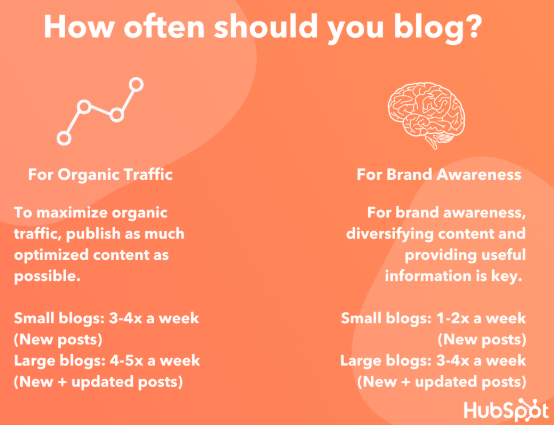
Let’s be honest: that’s a lot of content. This is especially true if you’re running a blog on a tight budget.
But let’s say you can’t commit to posting that often, either for the long-term or immediate future.
Maybe your freelance blogger disappeared. Perhaps there’s a shift in business’ content marketing strategy. Then what?
As evidenced by the COVID-19 situation, sometimes it’s necessary to put things on hold despite our best effort.
The good news? Making your blog look more evergreen and current is a cinch: simply remove dates from your post previews. To be clear, I’m talking about previews and not the posts themselves.
One of the most common B2B blogging mistakes I see is bloggers allowing their content to gather cobwebs. Removing post publish dates takes care of that problem in a snap.
Post publish dates versus no post publish dates
Let’s look at an example. Notice how blogs like Sprout Social couple their post previews with dates because they publish content on a near-daily basis. They rightfully want to emphasize to readers that they’re consistently pushing out new stuff. Makes sense, right?
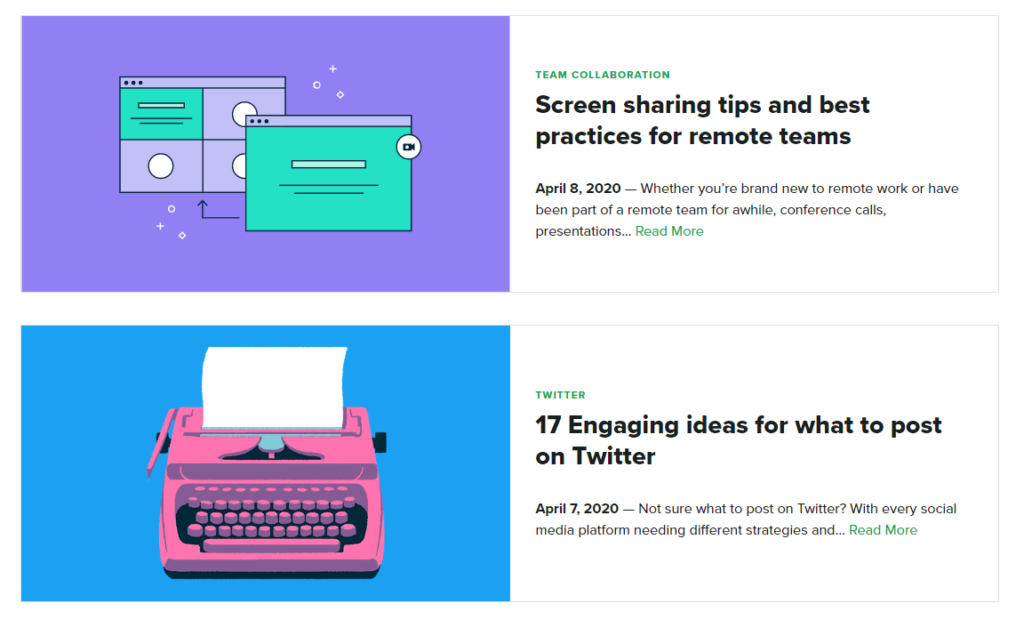
But let’s say there are gaps between your posts. If you can only commit to posting every two weeks or once a month, your post previews run the risk of looking outdated or otherwise irrelevant. You obviously don’t want your post previews to date back multiple calendar years.
That’s why removing dates from your post previews makes sense for blogs that post less frequently.
Here’s an example of a dateless preview page from Visme. Although Visme actually does post regular content, this preview page has the benefit of being evergreen. Note that some posts signal their timeliness by highlighting the year “2020” in their titles.
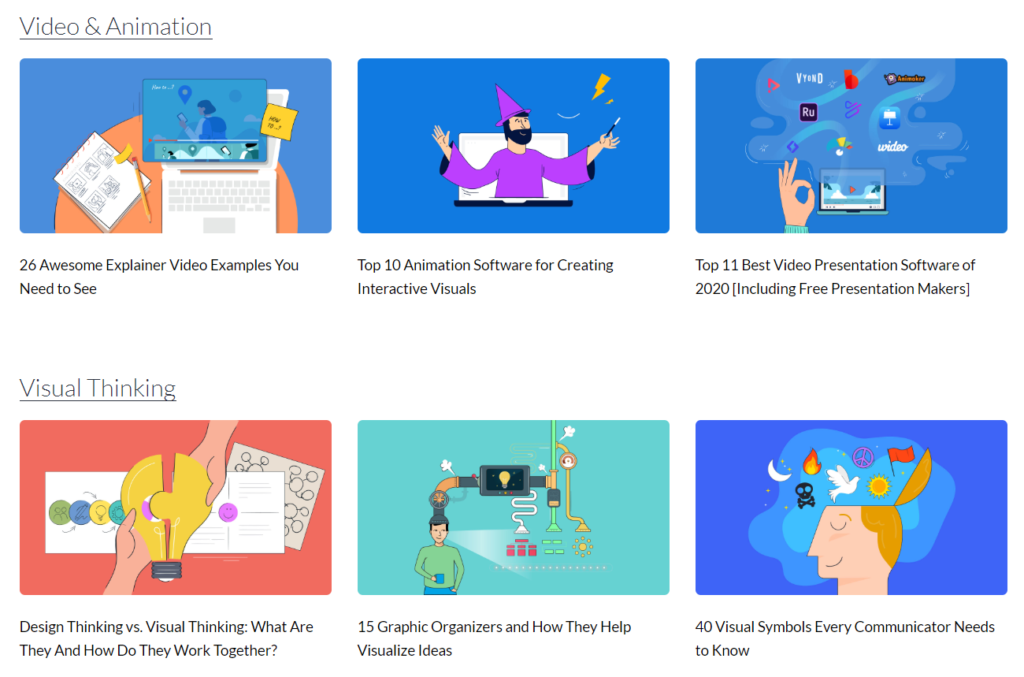
See how that works? If you’re in a situation where you’re just getting your B2B content strategy off the ground or can’t publish consistently, dateless preview pages make sense.
Don’t sweat it if you’re in that situation, by the way. Anecdotally, I’ve worked with clients who’ve posted once or twice a month intermittently and their blogs didn’t drop off the face of the earth (in fact, they grew traffic-wise).
It might be cliche, but posting something is better than nothing.
3. Integrate low-competition keywords into your content strategy
Let’s talk about one of the more common blogging mistakes for beginners in regard to SEO.
That is, punching above your weight.
Too often I see budding B2B blogs that are clearly targeting two-word, top-of-funnel keyword phrases that dominated by pillar posts from established blogs and household names.
Smaller blogs are better off targeting lower competition and long-tail keywords with specific search intent.
The value of this type of keywords strategy is well-documented, especially for up-and-coming sites that need to rank for something before they can worry about big-ticket terms.
Here’s another anecdote. My recent post on performing research as a SaaS writer managed to get on the front page of Google for multiple low-competition terms within a couple of months of being posted. The post has likewise resulted in relevant leads and opportunities despite having low search volume (10-20 search per month according to SEMRush).
Let’s look at another example. A keyword such as “CRM vs spreadsheet” has a low volume of searches but a very specific search intent. That is, someone searching such a term is either interested in a specific CRM or is trying to figure out whether or not they can get away with just using spreadsheets.
The SEMrush breakdown says the post gets ~30 searches per month, has a pretty damn high CPC for ads and is “Possible” in terms of difficulty.
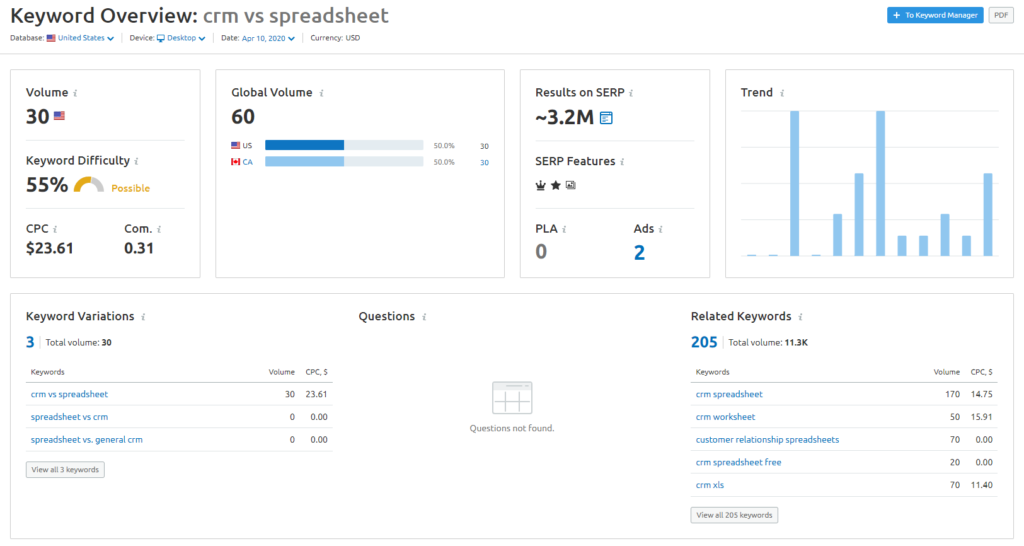
The top five Google results for this particular term are telling. While Capterra takes the top spot and the next three results are established blogs with good Domain Authority, the fifth result represents a relatively smaller blog with not too much traffic.
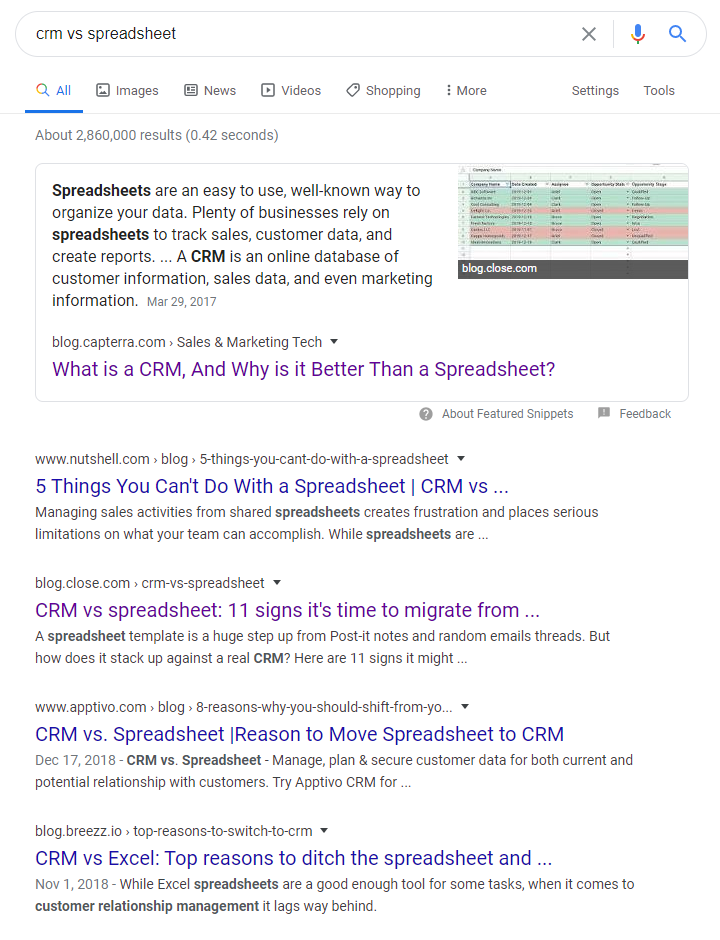
The aforementioned post is likewise a top-performer in terms of that particular blog’s organic search presence.
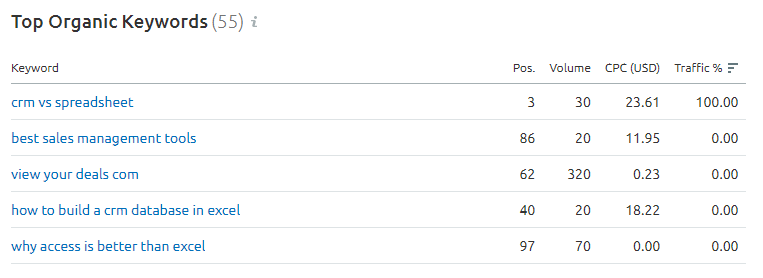
The takeaway here is that your blog content should focus on keywords that you can realistically rank for.
4. Don’t rely on a single type of blog post (hint: how-tos or lists)
I’ll bite: most of my blog posts for B2B clients are how-tos and listicles.
That said, it feels a bit spammy when I see a blog that exclusively publishes listicles that target exact-match keywords (ex: “11 of the best content marketing templates” or “11 benefits of CRM for business”). Such blogs seem like they’re targeting robots versus actual readers.
With so many blogs lacking much in terms of style or flavor, injecting some personality into your post titles and experimenting with different post types is a smart move.
Blogs like that of Drift to a brilliant job of putting together compelling headlines coupled with various types of blog posts. From case studies to interviews and long-form how-tos, their content strategy is a shining example of how B2B bloggers can get creative.

As noted in my guide to headline writing, blog post titles serve as the sort of “barrier to entry” which determine whether someone will read or share your content.
Below is a quick brainstorming session using CoSchedule’s headline analyzer. Any of these fictional post titles are totally fair game and highlight how bloggers aren’t tied to a single format for their headlines to be effective.
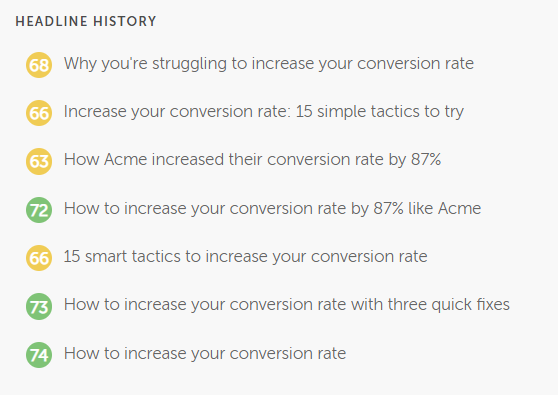
Ignoring your headlines and post formats is a B2B blogging mistake that makes your site look, well, boring.
And blogging doesn’t have to be boring. Nor should it be.
Even if how-tos and listicles are the cornerstones of your blog, at least take the time to experiment with different formats to see how they perform. You might be surprised.
Are You Avoiding These B2B Blogging Mistakes?
No blogger is immune to missteps in their content strategy.
However, some mistakes are easier to sidestep than others. The ones above are pretty straightforward.
Remember: a few mishaps here and there are bound to happen when you’re getting your blog off the ground.
By being aware of these common blogging mistakes, you’re more likely to put together posts that are appealing to readers and search engines alike.
And if you’d like to recommend any other easy-to-avoid mistakes or want to pick a B2B blogger’s brain, feel free to bug me on Twitter, comment below or shoot me an email.
This post was last updated on 4/12/2020.
Leave a Reply